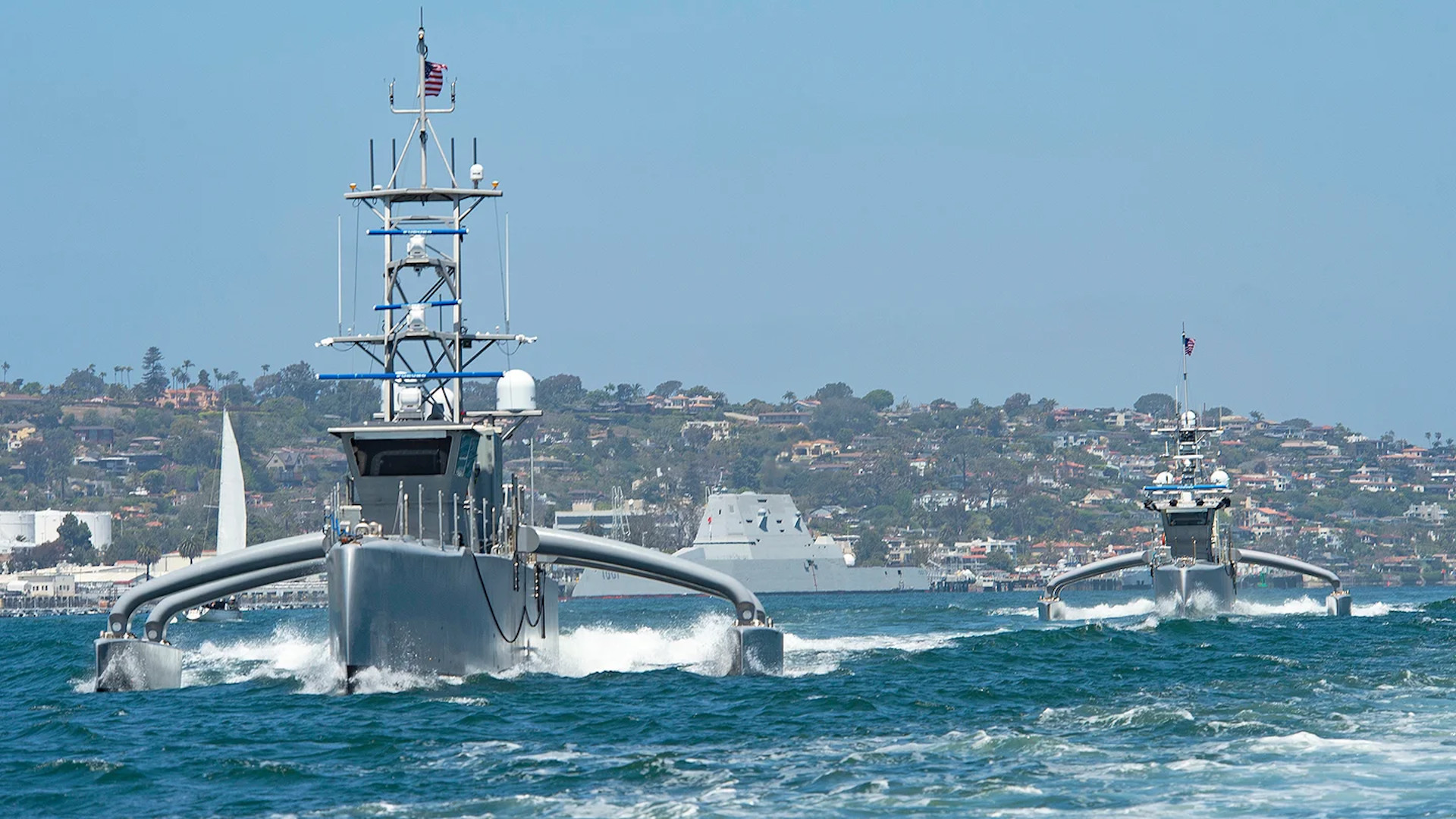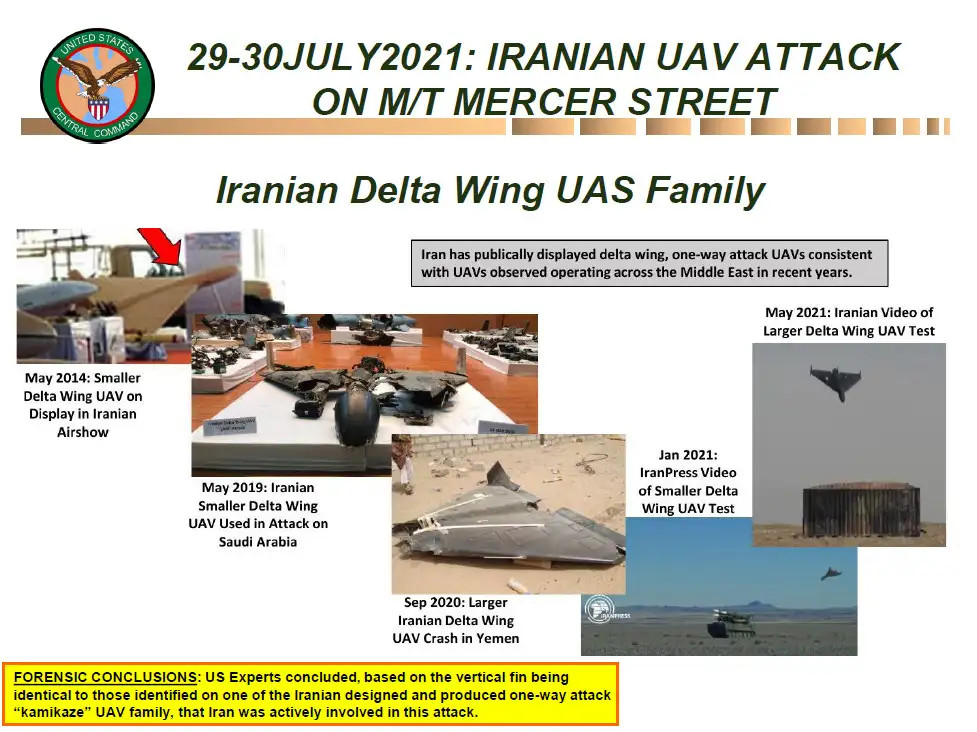The U.S. Navy's top command in the Middle East is set to stand up a new task force specifically to manage the use of the service's unmanned platforms across the region. This will include drones in the air, as well as unmanned surface vessels and unmanned underwater vehicles, or USVs and UUVs. The Navy hopes to use this force to improve its overall regional situational awareness, especially with regards to the activities of Iran and its proxies, among other missions, as well as just provide an operationally representative space to explore various new concepts of operations.
The Associated Press was among the first to report on the planned establishment of this new unmanned force earlier today. Navy Vice Admiral Brad Cooper, head of both 5th Fleet and Naval Forces Central Command (NAVCENT), which are often referred to collectively as 5th Fleet/NAVCENT, offered some additional details about the unit, which is expected to be called Task Force 59.

The Navy's numbered fleets are typically broken into different standing task forces responsible for overseeing the employment of different types of capabilities. At present, 5th Fleet/NAVCENT, which has its headquarters in Bahrain in the Persian Gulf, has nine such task forces. These include Task Force 50 and 51, which are responsible for managing the activities of carrier and expeditionary strike groups deployed to the region. Task Forces 52, 53, 54, and 55 handle mine warfare, logistics, submarine warfare, and surface warfare operations, respectively. Task Force 56, or the fleet's Expeditionary Combat Forces, oversees a variety of specialized capabilities, including explosive ordnance disposal and mobile construction units. Task Force 57 is the maritime patrol aircraft element within 5th Fleet/NAVCENT. Lastly, there is Task Force Shore Battlespace, which "coordinates all facility and security support for shore installations in the AOR [area of responsibility]," according to the fleet's website.
5th Fleet/NAVCENT had previously used Task Force 59 as a designation for temporary contingents assembled in response to regional contingencies. For instance, in 2006, an earlier Task Force 59 had been activated to help with the evacuation of Americans from Lebanon after a major conflict broke out that year between the militant group Hezbollah and Israel.
Now, the new Task Force 59 will shift its attention to unmanned operations. “We want to put more systems out in the maritime domain above, on and below the sea,” Vice Admiral Cooper said, according to The Associated Press. “We want more eyes on what’s happening out there.”
The Associated Press reported that the Navy did not specify what unmanned systems would fall under the task force's auspices. However, the outlet also said that it was its understanding that the full array of platforms would include some of those that the service had demonstrated during a huge unmanned-focused exercise, dubbed Unmanned Integrated Battle Problem 21, or UxS IBP 21, that was held off the coast of California earlier this year.
A wide variety of drones, USVs, and UUVs took part in UxS IBP 21, including types in service with the Navy now, as well as experimental platforms. In the air, there were examples of the Navy's operational MQ-8B Fire Scout drone helicopters, as well as an MQ-9B Sea Guardian, a maritime-focused variant of General Atomics' MQ-9 Reaper, and Vanilla Unmanned's Ultra-Long Flight Endurance Unmanned Air Vehicle. Down below were the Navy's two multi-purpose medium-displacement USVs, Sea Hunter and Seahawk. The smaller ADARO USV and various torpedo-shaped USVs that the service has in inventory now, as well as an unmanned vehicle from Ocean Aero that was capable of sailing on top of the waves and diving below them, also took part in the event, among other platforms. High-altitude balloons and swarming technology, among other things, were also demonstrated during the experiment. You can read more about what we know about UxS IBP 21, overall, here, though much of what happened during the event remains classified.
Any combination of these platforms, or other similar unmanned systems, would be a valuable addition to 5th Fleet/NAVCENT's arsenal. They could be especially useful for monitoring activities in, around, and above various waterways in the Middle East, including the highly strategic Strait of Hormuz that links the Persian Gulf to the Gulf of Oman and the Bab Al Mandeb Strait that connects the Red Sea to the Gulf of Aden.
Iran and its regional proxies have been blamed for a variety of malign actions, including attacks on commercial ships, and civilian targets along various coastlines, in or near these waterways, as well as elsewhere in the Middle East, in the past few years. Unmanned platforms, including so-called "suicide drones" or "kamikaze drones," as well as explosive-laden drone boats, have actually been used to carry out many of these attacks.

Unmanned platforms would offer new ways, as well as just additional capacity, to patrol across the region for these kinds of threats, among others, on a more persistent basis, and do so in the face of factors that might limit the endurance or overall utility of certain manned aircraft and vessels. "The 5th Fleet includes shallow water areas, salty waters and temperatures in the summertime that can go above 45 degrees Celsius (113 degrees Fahrenheit) with high humidity," The Associated Press story noted, conditions that can be rough on crews and equipment alike.
“I think that environment really suits us well to experiment and move faster," Vice Admiral Cooper said. "And our belief is if the new systems can work here, they can probably work anywhere else and can scale them across other fleets.”
Increase the use of unmanned systems could also help free up manned vessels, especially larger surface warships and submarines, as well as aircraft, for higher priority missions. The employment of unmanned platforms also reduces the risks to actual Navy personnel, which could, in turn, help prevent crises from escalating. At the same time, hostile actors, such as Iran, could be more inclined to harass, or even damage or destroy, unmanned platforms, due to this reduced potential for escalation.
The video below shows the Navy's Cyclone class patrol craft USS Firebolt firing warning shots at boats belonging to Iran's Islamic Revoutionary Guard Corps during an altercation in the Persian Gulf in April 2021.
Beyond all this, as Vice Admiral Cooper noted, the Middle East also just offers a good region for the Navy to begin putting various unmanned operations concepts to the test. Overall, 5th Fleet/NAVCENT's area of responsibility offers a multi-faceted testing ground where the service can push unmanned technologies forward to more quickly understand and integrate them into day-to-day activities in an operationally relevant environment.
This wouldn't be the first time the Navy has utilized 5th Fleet/NAVCENT in this way, either. For years, the Navy has operated a fleet of RQ-4A Global Hawk drones, referred to as Broad Area Maritime Surveillance-Demonstrators (BAMS-D), in the region. Experience with those unmanned aircraft helped inform the service's concepts of operations for its new MQ-4C Triton drones, which are Global Hawk derivatives configured specifically for maritime operations. Iran notably shot down one of the BAMS-D drones down in 2019, also underscoring the potential dangers unmanned platforms might face in the region.
Lessons learned from Task Force 59's activities could very well be applicable to other numbered fleets, such as 3rd and 7th Fleets in the Pacific region. One would imagine that other fleets are also now looking into standing up unmanned-centric task forces.
At the same time, it is interesting that 5th Fleet/NAVCENT has chosen to put all of its unmanned capabilities together rather than integrating specific types with their manned counterparts under the oversight of its existing task forces. The UxS IBP 21 experiment notably focused heavily on manned-unmanned teaming concepts, among others. The EOD elements within Task Force 56 should also already have various UUVs and it's not clear whether the creation of Task Force 59 will have an impact on how those platforms are employed. The creation of the new unit will certainly present an opportunity to see if this kind of command and control structure is the most effective.
All told, 5th Fleet/NAVCENT now looks set to become an incubator of sorts for the Navy to begin moving a variety of unmanned concepts of operation out of the realm of experimentation and into actual day-to-day operations in the Middle East and beyond.
Contact the author: joe@thedrive.com
